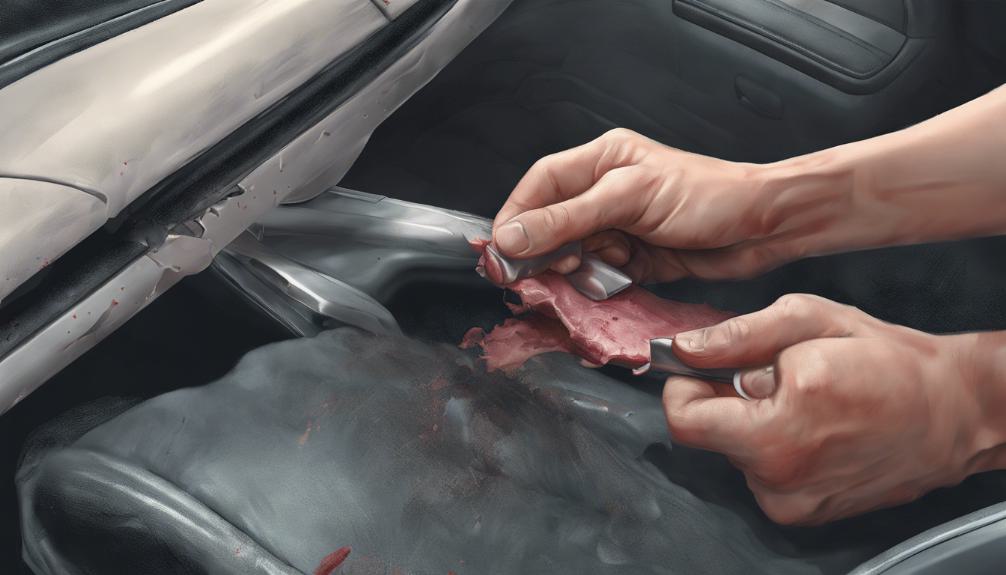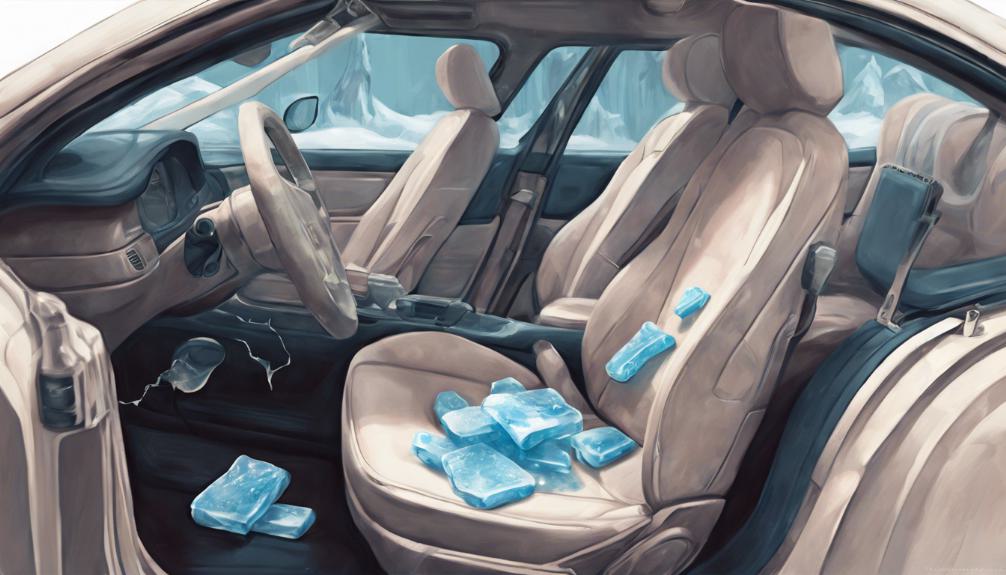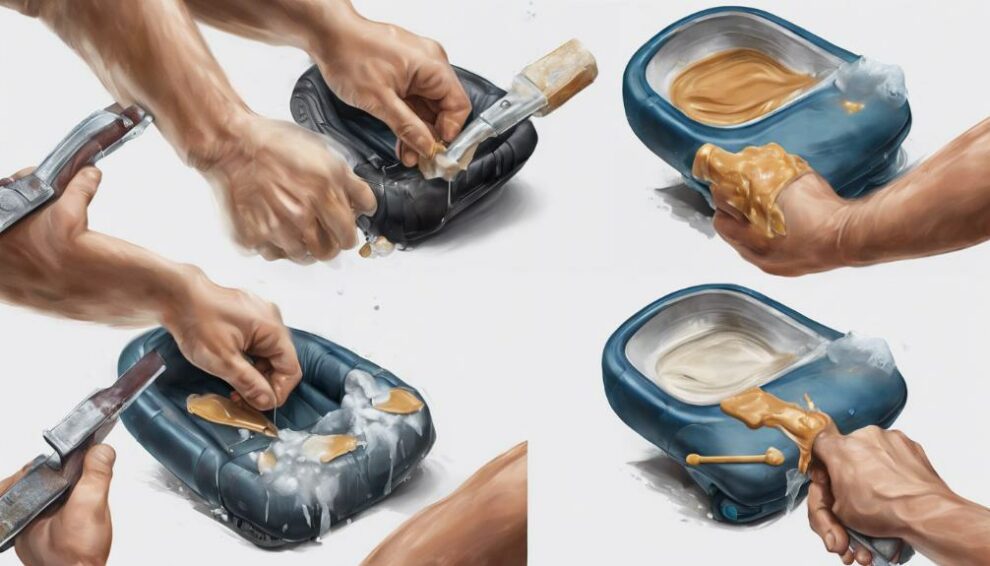To remove gum from your car, start by scraping it off with a palette knife or plastic razor blade. Be gentle to avoid damage. Bug and Tar Remover can help dissolve stubborn residue; apply, scrape, and repeat if needed.
Another option is to freeze the gum with compressed air, making removal easier. Apply peanut butter generously to break down the gum, wiping it away afterward.
Consider using a d-limonene cleaner or rubbing alcohol for effective results. Vinegar solution can also help soften gum. For tough spots, a heat gun or hairdryer can efficiently soften the gum.
More methods await discovery in your quest for a gum-free car.
Key Points
- Scrape off gum with a palette knife or razor blade.
- Use Bug and Tar Remover for sticky residue.
- Freeze gum with compressed air for easy removal.
- Apply peanut butter to break down gum.
- Consider cleaning solutions like d-limonene or vinegar.
Scrape off the Gum

When removing gum from your car, begin by using a palette knife or plastic razor blade to scrape off the sticky residue.
These gum removal techniques are effective in getting rid of the stubborn gum stuck on your car’s surface. By gently scraping with the palette knife or razor blade, you can prevent gum residue from spreading further.
It’s important to exercise caution to avoid scratching or damaging the car’s paintwork.
To make sure a thorough removal process, prepare a basin of soapy water to assist in loosening the gum residue. After scraping off the gum, use a towel or sponge to clean the car side with the soapy water.
This step not only helps in removing any remaining gum residue but also prevents new gum from sticking to the same spot in the future. Following these steps diligently will leave your car looking clean and gum-free.
Use Bug and Tar Remover
For effective removal of gum residue from your car, consider utilizing bug and tar remover.
This product is designed to break down the sticky residue through a chemical reaction, making it easier to remove from the surface of your vehicle.
When using bug and tar remover, focus on applying it to the edges of the gum spot to guarantee proper coverage and effectiveness in dissolving the gum base.
After application, gently scrape off the gum residue using a plastic razor blade. This process helps to protect the surface of your car from scratches while effectively removing the gum.
If there’s any remaining gum residue, reapply the bug and tar remover as needed until the spot is completely clean.
Bug and tar remover not only aids in gum removal but also provides surface protection, making it a valuable tool in maintaining the appearance of your vehicle.
Freeze the Gum

To freeze the gum on your car, utilize compressed air to solidify it for easier removal. Freezing the gum with compressed air has its benefits when it comes to gum removal alternatives.
Here are some helpful tips for freezing the gum effectively:
- Direct the compressed air nozzle at the gum from a close distance to freeze it quickly.
- Hold the compressed air nozzle steady for a few seconds to guarantee the gum solidifies properly.
- Gently tap or scrape the frozen gum with a plastic scraper to lift it off in manageable pieces.
- Refreeze the gum if it starts to soften during removal to maintain its solid state.
Utilizing freezing benefits can make the gum removal process less messy and more efficient. By following these steps, you can effectively freeze the gum on your car and prepare it for easy removal without damaging the surface.
Apply Peanut Butter
If you’re looking for an alternative method to remove gum from your car after freezing it with compressed air, consider applying smooth peanut butter to help break down and loosen the gum.
Peanut butter can be a surprising but effective solution for this sticky situation. One of the pros of using peanut butter is its natural adhesive properties, which can help grip the gum and make it easier to remove.
Also, peanut butter is readily available in most households, making it a convenient option for quick cleanup.
To use peanut butter for gum removal, simply apply a generous amount around the gum spot and let it sit for a few minutes.
The oils in the peanut butter will work to break down the gum, making it easier to wipe away. Use a gentle cloth to wipe off the peanut butter along with the gum.
For stubborn gum spots, you may need to repeat the process a few times until the gum is completely removed.
Peanut butter alternatives can include other nut butters or oils with similar adhesive properties.
Some car owners have shared success stories using peanut butter removal hacks, praising its effectiveness in tackling stubborn gum spots.
Try a Cleaning Solution

Consider utilizing a cleaning solution to effectively address gum stuck on your car’s exterior. Here are some DIY hacks and eco-friendly alternatives to help you tackle this issue:
- Use a d-limonene cleaner: Opt for a cleaner containing d-limonene, commonly found in citrus-based cleaners, to effectively remove gum from your car’s exterior.
- Direct application: Apply the cleaning solution directly on the gum to soften it, making it easier to remove.
- Gentle wiping: After softening the gum, wipe off the residue from your vehicle using a soft cloth to check damaging the surface.
- Safety check: Make sure to check the label of the cleaner for d-limonene content to verify its efficiency and safety for your car’s surface.
These methods are efficient, safe, and environmentally friendly, providing you with effective solutions to get rid of gum without causing harm to your vehicle.
Utilize Rubbing Alcohol
Enhance your gum removal process by incorporating rubbing alcohol as a solution.
Rubbing alcohol effectively breaks down the stickiness of gum on car surfaces, making it easier to dissolve and remove the residue. Its quick evaporation leaves behind a clean surface.
To utilize rubbing alcohol, soak a cloth in it and gently dab the gum to lift it off. Before proceeding, test a small area to confirm the rubbing alcohol won’t damage the car’s paint or finish.
When using rubbing alcohol, consider alcohol alternatives for safe application.
Remember to be cautious of the environmental impact and guarantee proper disposal of any materials used in the process.
Rubbing alcohol provides a straightforward and efficient method for removing gum from your car, so be sure to follow these steps carefully for successful gum removal.
Can Beeping in My Car Lead to Gum Getting Stuck in it?
If you hear beeping in your car, it is essential to investigate the reasons for car beeping. While it is unlikely for the beeping to directly cause gum to get stuck in the car, it’s crucial to address any car issues promptly to prevent potential accidents or inconveniences.
Apply Vinegar Solution

For effective removal of gum from your car, consider applying a vinegar solution. Vinegar has several benefits that make it an excellent choice for gum removal techniques:
- Natural and Effective: Vinegar is a natural and effective solution for removing gum from car surfaces.
- Acidity Breakdown: The acidity in vinegar helps break down the gum residue for easier removal.
- Gentle Cleaning: Mixing vinegar with water creates a gentle yet powerful cleaning solution.
- Safe for Car Materials: Vinegar is safe to use on various car materials like metal, glass, and plastic.
To utilize the vinegar solution effectively, apply it to the gum and let it sit for a few minutes. This allows the vinegar to penetrate the gum, enhancing its effectiveness in loosening the sticky residue.
Once the gum has softened, you can gently scrape it off using a plastic scraper or an old credit card. Wipe the area clean with a damp cloth to remove any remaining vinegar and gum residue.
Use a Heat Gun
To tackle stubborn gum residue on your car, employing a heat gun can be a practical method to soften and remove the sticky mess effectively. When using a heat gun, it’s important to prioritize safety precautions.
Keep the heat gun at a recommended distance from the car’s surface to prevent any damage to the paint. Apply the heat in short bursts to gradually soften the gum without overheating it.
It’s essential to note that there are alternatives to using a heat gun for gum removal. One option is using a hairdryer on high heat as a substitute.
However, the heat gun tends to be more powerful and can expedite the process.
The pros of using a heat gun include its efficiency in softening the gum quickly and its versatility for other tasks. On the other hand, a potential con is the risk of causing damage if not used carefully.
As an Amazon Associate we earn from qualifying purchases.










